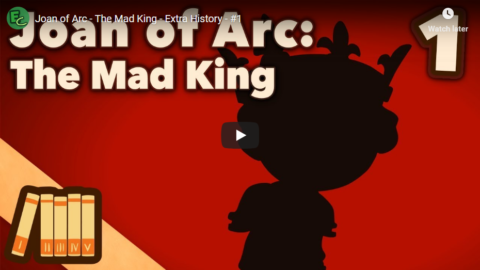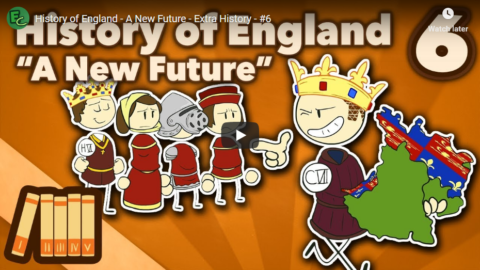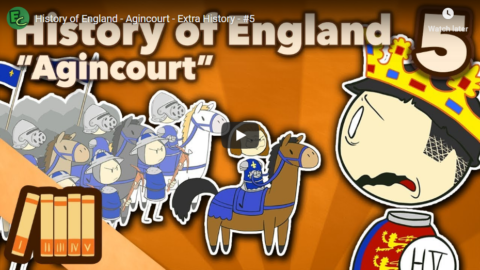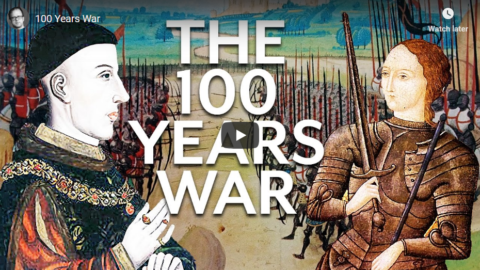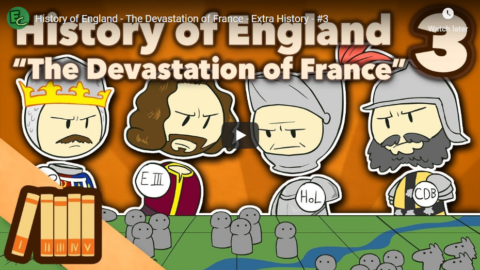Extra Credits
Published on 6 Jul 2019Before we can really get into Joan of Arc’s life, we have to get a bit into the civil war between the Burgundians and the Armagnacs. Time for some royal family drama with King Charles VI’s madness and Queen Isabeau’s friend Louis.
Follow us on Instagram: http://bit.ly/ECisonInstagram
Join us on Patreon! http://bit.ly/EHPatreon
July 7, 2019
Joan of Arc – The Mad King – Extra History – #1
July 1, 2019
History of England – A New Future – Extra History – #6
Extra Credits
Published on 29 Jun 2019The 116-year struggle helped define and unite the English. In France, the wars forced the kings to tackle the separatist forces, and France would become the undisputed arbiter of Europe.
Thanks again to David Crowther for writing AND narrating this series! https://thehistoryofengland.co.uk/pod…
Join us on Patreon! http://bit.ly/EHPatreon
June 24, 2019
History of England – Agincourt – Extra History – #5
Extra Credits
Published on 22 Jun 2019Henry V was formidable and ruthless. Leading an army struck by dysentery, he pressed on to claim more large swaths of France, forming the irresistible Anglo Burgundian alliance.
Henry V is a serious contender for the most impressive man ever to rule England. On his death, a chronicler wrote: “He did not leave his like upon earth among Christian kings or princes.” His only fault was to die young… well, that, and being so horrifically ruthless and cold, that another historian wrote of Henry that he was “conclusive proof that a man may be a hero and yet a monster.”
Thanks again to David Crowther for writing AND narrating this series! https://thehistoryofengland.co.uk/pod…
Join us on Patreon! http://bit.ly/EHPatreon
June 17, 2019
100 Years War
Ryan Reeves
Published on 2 Jul 2014The 100 Years War between France and England lasted more than 100 years and was not one war but many. We explore Henry V and other important kings, and finish by exploring Joan of Arc as the savior of France.
Ryan M. Reeves (PhD Cambridge) is Assistant Professor of Historical Theology at Gordon-Conwell Theological Seminary.
Twitter: https://twitter.com/RyanMReevesWebsite: http://www.gordonconwell.edu/academic…
For the entire course on ‘Church History: Reformation to Modern’, see the playlist: https://www.youtube.com/playlist?list…
June 16, 2019
History of England – Ashes – Extra History – #4
Extra Credits
Published on 15 Jun 2019Bertrand du Guesclin was the hero the French needed. Focused on fortifying defenses and cities, Guesclin rebutted the advances of the Black Prince — who ended up contracting an illness that undid his iconic image of triumph and chivalry. Edward became beset by drama in the royal court, and England started to lose power…
Thanks again to David Crowther for writing AND narrating this series! https://thehistoryofengland.co.uk/pod…
Join us on Patreon! http://bit.ly/EHPatreon
June 9, 2019
History of England – The Devastation of France – Extra History – #3
Extra Credits
Published on 8 Jun 2019From the end of the battle of Crecy, Edward charged on to besiege Calais (successfully), and then returned home. Right about then was when the Black Plague hit Europe head-on. But Edward carried on as king establishing order among his subjects, forming the Knights of the Garter. In France, John le Bel, son of Philip, had learned from the French defeats and was making small victories here and there…
In the middle ages, pillaging and murdering your way across Northern France was clearly considered an appropriate father-son bonding opportunity.
Thanks again to David Crowther for writing AND narrating this series! https://thehistoryofengland.co.uk/pod…
Join us on Patreon! http://bit.ly/EHPatreon
June 2, 2019
History of England – Fire and Swords – Extra History – #2
Extra Credits
Published on 1 Jun 2019On the 26th of August,1346, Philip’s army drew near the English force. The French were strung out for miles. Phillip’s best commanders advised caution: put on those comfy jim-jams the Queen gave you last Christmas, don the royal slippers, get a goodnight’s snooze, and let everyone catch up, then drown the English in a river of their own blood after a light breakfast. But Phillip looked upon the current puny size of the English army, and ordered the attack anyway…
Thanks again to David Crowther for writing AND narrating this series! https://thehistoryofengland.co.uk/pod…
Join us on Patreon! http://bit.ly/EHPatreon
Experiment 2 for social media thumbnails:
May 26, 2019
History of England – The 100 Years War – Extra History – #1
Extra Credits
Published on 25 May 2019At stake on the English side was trade, the English role in Christendom, the king’s lands in France held by right for 150 years, and the reputation and honor of the king. On the French side, a unified country, national prestige, and the right of their monarch to his own throne.
Thanks again to David Crowther for writing AND narrating this series! https://thehistoryofengland.co.uk/pod…
Join us on Patreon! http://bit.ly/EHPatreon
May 15, 2018
French protests over new British submarine in three, two, one…
Gareth Corfield helpfully sums up the reasons for the French to take offence after the Royal Navy chose to name the next Astute-class nuclear submarine HMS Agincourt:
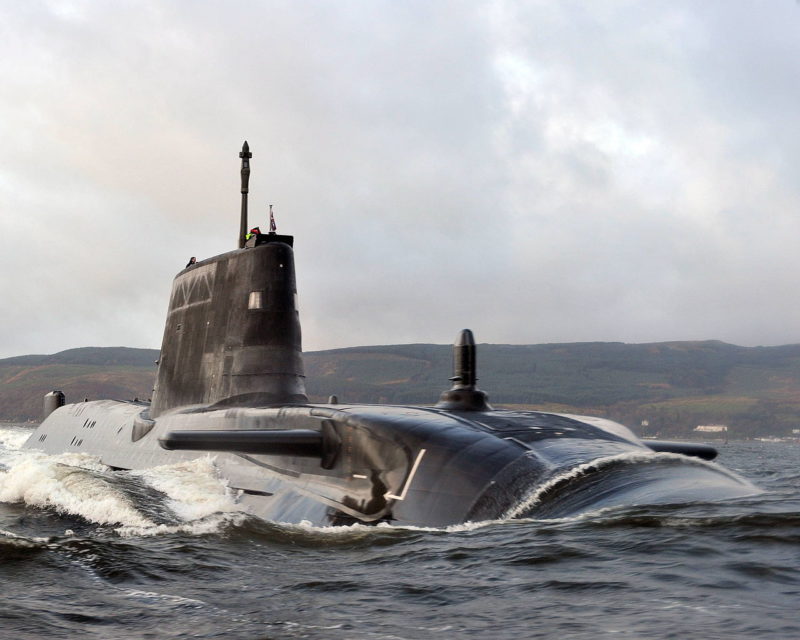
HMS Astute (S119), lead ship of her class, sails up the Clyde estuary into her home port of Faslane, Scotland.
MOD photo, via Wikimedia Commons.
The Royal Navy, always keeping up with the times, has named its newest attack submarine HMS Agincourt, after the 1415 battle where an English army beat French troops led by its nobility.
Agincourt the boat is the seventh and final Astute-class attack sub. The nuclear-powered vessels are used primarily to defend British interests from underwater, including seeing off marauding Russian vessels near British waters and also for sneaky-beaky missions of their own into foreign waters.
The £1.5bn submarine is under construction at BAE Systems’ yard in Barrow-in-Furness, Cumbria. Defence equipment minister Guto Bebb joyously declared: “Today’s announcement includes a £60m contract for Rolls-Royce, supporting over 700 jobs here in Derby as the factory continues to make the reactors that will power our state-of-the-art Dreadnought subs into the 2060s.”
And just to rile up any sensitive French souls, he also gives a thumbnail history of the battle the ship will be named for:
The name Agincourt is mildly controversial, inasmuch as it brings to mind the famous victory of King Henry V over France at a time where the English army, which was blundering around the Pas-de-Calais countryside, was largely thought to be on its last legs and cut off from its chances to retreat back home. In the words of the king’s (fictional, thanks to Shakespeare) eve-of-battle speech, it was “we few, we happy few, we band of brothers” up against the very best France had to offer.
Through “yew bow and cloth yard shaft”, as the chroniclers of the day put it, the English and Welsh longbowmen shot a torrent of arrows into the heavily armoured French knights. The arrows’ steel points penetrated the plate armour of the French nobles and the lightly equipped English then set about the bogged-in Frenchmen, whose weighty suits of armour were totally unsuited to the heavy mud of the battlefield.
In today’s world, where the UK and France are close allies and England has given way to the United Kingdom, naming the submarine Agincourt may be seen by some as a bit of an unintentional snub, bringing to mind Henry V’s slaughter of French prisoners of war and the failed negotiations that preceded the battle over Henry’s disputed claim to the title of King of France.
June 20, 2014
The Black Death, the peasants’ revolt, and … tax increases
Put yourself in the position of an advisor to the 10-year old King Richard II shortly after his coronation in 1377. You’ve just witnessed one of the greatest population disasters in European history — the Black Death — where one third of the people of all classes died. The crown is at war with France (the Hundred Years’ War), and there’s little or no money in the treasury. You could probably come up with better policy ideas in your sleep than what Richard’s advisors did:
Fixated with outright victory in the One Hundred Years War, started by his grandfather Edward III, Richard’s government introduced hugely unpopular poll taxes in 1377 and 1379. A further tax introduced in 1381 was to be the straw that broke the camel’s back. Irrespective of wealth, the tax was fixed at a rate of 12 pence per person, meaning that it was a huge burden on the poor, but a minor inconvenience to the wealthy. In addition, rumours spread of widespread corruption in the government. The peasants were ripe for revolt.
Following the expulsion of a tax collector from the town Brentwood, 30 kilometres north-east of London, a band of rebels swept through Kent and Essex, swelling their numbers with volunteers as they went. They advanced upon London in a pincer movement from the south and east. The two leaders of the rebellion emerged as Wat Tyler, of whom little was previously known, and John Ball, a radical priest who had been broken out of prison by Kentish rebels, where he had been held for his beliefs in social equality and a fair distribution of wealth within the church. Indeed, as he preached to the crowd of thousands of rebels at Blackheath, then just outside London, he cried: ‘When Adam delved and Eve span, Who was then the gentleman? From the beginning all men by nature were created alike, and our bondage or servitude came in by the unjust oppression of naughty men.’
Londoners willingly opened the gates of their city to the rebels who set about their task with fervour. They sacked Savoy Palace, the home of the key adviser to the now 14-year-old Richard. Guards in the Tower of London opened the gates to the rebels, who freed the inmates and executed Simon Sudbury, the Archbishop of Canterbury and Lord Treasurer of England, who had been hiding inside. There were also several incidents of misplaced rage among the rebels, like when the crowd set their sights upon Flemish immigrants, many of whom were wealthy wool merchants, and murdered them in the streets.
Faced with a grave situation, the young king rode out to meet the rebel leaders at Blackheath. Their demands were an end to poll taxes, an immediate end to serfdom, the introduction of a more democratic form of government with local representation based on the Provisions of Oxford in 1258, and a fair distribution of wealth and power from the nobility. Richard initially gave into their demands as well as issuing pardons for all involved.
It got worse (for the peasants) after that brief high point…
December 5, 2013
The Hundred Years War
In History Today, George Goodwin reviews A Great and Glorious Adventure: A Military History of the Hundred Years War by Gordon Corrigan:
As Corrigan explains, the Hundred Years War extended over a longer period (1337-1453) than its name suggests, but then it was not a continuous war either. Instead its series of intermittent campaigns featuring major battles and sieges was interspersed with periods of lower tempo siege warfare and long stretches of peace. The war was initially sparked by Philip VI of France’s formal declaration that Edward III’s territories in France (most notably Aquitaine) had been confiscated because the young English king had refused to act as his vassal and to hand over Robert of Artois, Philip’s mortal enemy. The war escalated after the Declaration of Ghent in 1340, when Edward proclaimed himself king of France on the basis that, through his mother, he had a superior claim to the throne than Philip, as she was the daughter of Philip IV, while Philip VI was merely his nephew. France, however, had never allowed for kingship to descend through the female line.
Corrigan’s dramatic description of the Battle of Sluys in 1340 gets the book going. Though fought between opposing navies, Sluys was essentially a land battle that took place on a flotilla of French ships chained across the mouth of an estuary, with the victorious English army moving from vessel to vessel and pushing their French opponents overboard. Corrigan accounts for England’s victory being due to superior tactics and the far greater effectiveness of the longbow in comparison to the French crossbow. This was down to both to the nature of the weaponry and the superior skill of the Anglo-Welsh archers. They proved decisive time and time again at the great set-piece battles of Crecy, Poitiers, Agincourt and Verneuil.

